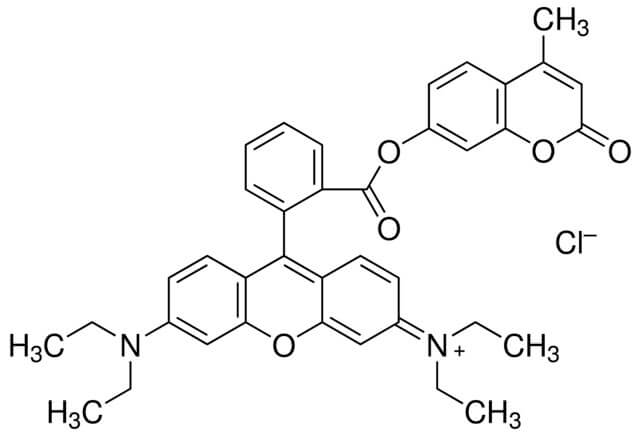All AbMole products are for research use only, cannot be used for human consumption.

For this product's availability, delivery time and price, please email [email protected] directly or click the "Inquiry Now" button below.
Mito Red is a cell membrane permeable rhodamine based dye. It localizes mitochondria, and emits red fluorescence. The interaction of Mito Red with mitochondria depends of the membrane potential of the mitochondria. Mitochondria can be stained with 20-200 nM of Mito Red. MitoRed (Mito Red), a vital dye and mitochondrial stain, is used to indicate the status of mitochondria under various physiological and physical conditions.
| Molecular Weight | 637.16 |
| Formula | C38H37ClN2O5 |
| CAS Number | 1021902-10-2 |
| Solubility (25°C) | DMSO |
| Storage | 2-8°C, protect from light, sealed |
| Related Fluorescent Dye Products |
|---|
| FITC Palmitate
FITC-Palmitate is a fluorescently labelled fatty acid derivative made by chemically coupling fluorescein isothiocyanate (FITC) with a long chain fatty acid, palmitic acid. Due to its combination of fat solubility and green fluorescent signals, it has a variety of uses in biomedical and cell biology experiments. |
| PGSK diacetate (5/6-mixture)
PGSK diacetate (5/6-mixture) is a metal ion-sensitive fluorescent probe that can penetrate cell membranes. PGSK diacetate can react with a variety of metal ions, including Fe2+, Cd2+, Co2+, Ni2+, Zn2+, etc. PGSK diacetate chelates Fe2+, resulting in fluorescence quenching, which can be restored when a membrane-permeable chelator is added, thereby reflecting the changes in the intracellular chelatable iron pool. The excitation/emission maxima of PGSK diacetate are 507/532 nm, respectively. |
| Dextran-Rhodamine B
Dextran-Rhodamine B (RB-Dextran) is a fluorescent marker made by combining rhodamine B fluorescent dye and dextran polysaccharide through a specific chemical reaction. RB-Dextran is a red fluorescent modified dextran polysaccharide formed by chemically labeling rhodamine B onto dextran molecules, which can be used in cell tracing, biofluid dynamics research and other fields, and its fluorescent properties can be used to track the distribution and metabolism of dextran in organisms and other processes. |
| N-Succinimidyl 6-(2,4-Dinitroanilino)hexanoate
N-Succinimidyl 6-(2,4-Dinitroanilino)hexanoate, the DNP-X acid modified by succinimidyl ester, is an amine-reactive building block for developing a probe, which can be recognized by anti-DNP antibodies. |
| FITC-Arachidonic Acid
FITC-Arachidonic Acid is a fluorescent labelled compound for biomedical research. FITC-Arachidonic Acid combines the biological activity of arachidonic acid and the fluorescent properties of FITC, and is suitable for the study of cellular signalling, lipid metabolism and so on. |
All AbMole products are for research use only, cannot be used for human consumption or veterinary use. We do not provide products or services to individuals. Please comply with the intended use and do not use AbMole products for any other purpose.


Products are for research use only. Not for human use. We do not sell to patients.
© Copyright 2010-2024 AbMole BioScience. All Rights Reserved.
